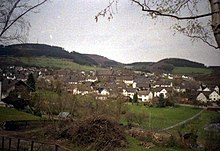Hesborn
|
Hesborn
City of Hallenberg
Coordinates: 51 ° 8 ′ 59 ″ N , 8 ° 37 ′ 39 ″ E
|
|
|---|---|
| Height : | 474 (459-522) m |
| Area : | 14.18 km² |
| Residents : | 1000 (2005) |
| Population density : | 71 inhabitants / km² |
| Incorporation : | 1st January 1975 |
| Postal code : | 59969 |
| Area code : | 02984 |
|
Aerial photo (2013)
|
|
Hesborn is a district of the town of Hallenberg in the Hochsauerlandkreis , North Rhine-Westphalia .
Geographical location
Hesborn is located in the southern part of the Hochsauerlandkreis, just under 4.5 km north of the Hallenberg town center. It is located on the foothills of the Rothaargebirge below the southeast flank of the 757.7 m above sea level. NN high Bollerberg , on which the observation tower Bollerbergturm stands. The Nuhne tributary Olfe ( Ölfe ) runs through the village and also the state road 617, which connects Liesen in the south-south-west through Hesborn with Medelon in the north-east.
history
The place Hesborn, another documented spelling Hersporen , is a foundation from the 11th century. This is assumed because the church tower was first mentioned in 1126 in the year it was built.
On the Stolzenberg (623 m), located about 1 km north of the town center, there are still remnants of the ramparts of a medieval castle that was documented as destroyed in 1694 and under whose protection the settlements Wolmerkusen (now desolate ) and Hesborn arose. From the 14th century to around 1420, the Stolzenburg was the property of the lords of Wolmeringhausen , who then migrated to the Waldecksche and who died out in 1635 as a male , who belonged to the electoral Cologne castle men of Hallenberg.
The Count of Waldeck was entitled to tithe in 1269 .
The nave of the Catholic parish church St. Goar was built in 1914.
On March 29, 1945 around noon, US troops advancing from the Hessian region drove through Hesborn around 9 a.m. without a fight, as there were neither the Wehrmacht nor the Volkssturm in the village. White towels were hung from some houses. On March 29th and 30th, major American units marched through the village. On the 31st there were short fighting north of Liesen during counterattacks by the Wehrmacht. Because of artillery fire, residents fled to the forest on the Bollerberg with cattle and belongings. Fallen German soldiers were later buried in the village cemetery. Until April 14, Hesborn was occupied by larger troop units. The US troops searched Hesborn for soldiers, registered the male population and confiscated weapons, cameras and binoculars. In the east and south-east, gun batteries were positioned on the heights, which fired on targets in Züschen, Winterberg and Glindfeld until they were withdrawn on April 14th. Schools, stopped Wehrmacht vehicles and depots were looted. "Anti-social German elements" and foreign workers were made responsible for this. At times there were problems with plundering former prisoners of war and forced laborers in the next few weeks until they were removed. Among other things, house No. 19 (Kleinsorge) was attacked on the night of July 6th. In the Second World War, 81 Hesborner died as soldiers, most of them on the Eastern Front , or died in captivity.
Until 1974 Hesborn belonged to the Brilon district . On January 1, 1975, Hesborn was incorporated into the city of Hallenberg. Since then the place belongs to the Hochsauerlandkreis. The Catholic parish church of St. Goar has an old tower. The baroque altars were taken over from the former Augustinian monastery in Glindfeld . In 1989 the church was completely restored.
Others
- There is a community center with a youth room in the school, which has been closed since the 1980s, and a Catholic kindergarten .
- Hesborn is the headquarters of Borbet GmbH .
- Hesborn also has a forest youth tent site , which is located in the north of the village behind the sports field.
literature
- Hugo Cramer: The district of Brilon in the Second World War 1939–1945 - reports from many employees from all over the district. Josefs-Druckerei, Bigge 1955.
Web links
- hesborn.net
- Website of the city of Hallenberg
- Hesborn in the Westphalia Culture Atlas
Individual evidence
- ↑ https://www.hesborn.net/geschichte1
- ↑ August Heldmann: About the headquarters of the Wolmeringhausen family. In: Journal for patriotic history and antiquity , Volume 46, Münster, 1888, pp. 96-106 (here 1904)
- ^ Josef Rüther: History of the district of Brilon , Regensberg Verlag, Münster, 1957, p. 367 u. 368
- ^ Hugo Cramer: The district of Brilon in the Second World War 1939-1945 . 1955, section Hesborn, pp. 32-3.
- ^ Hugo Cramer: The district of Brilon in the Second World War 1939-1945 . 1955, Honor Roll Section Hesborn, pp. 205–207.
- ^ Federal Statistical Office (ed.): Historical municipality directory for the Federal Republic of Germany. Name, border and key number changes in municipalities, counties and administrative districts from May 27, 1970 to December 31, 1982 . W. Kohlhammer, Stuttgart / Mainz 1983, ISBN 3-17-003263-1 , p. 332 .


